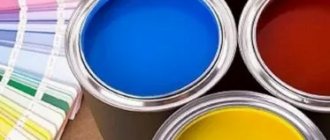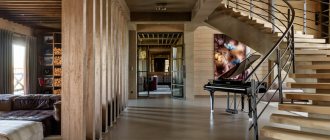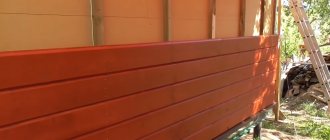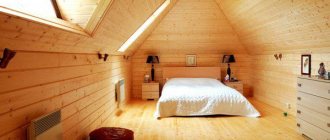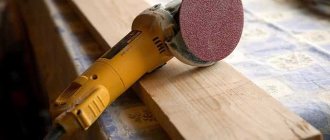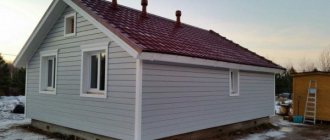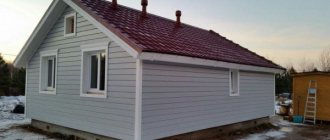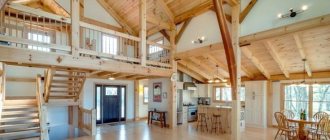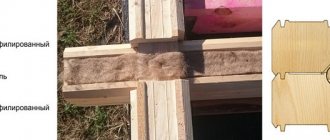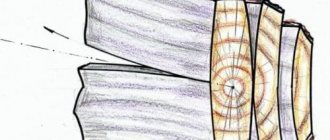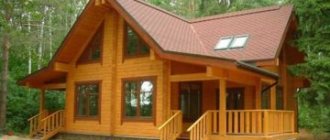Have you ever wondered what kind of glue companies use when building houses from laminated veneer lumber? Indeed, often, when making a choice in favor of wooden housing construction, in particular houses made of laminated veneer lumber, the buyer is guided by the principles of environmental friendliness of the future home. However, it happens that companies, in pursuit of profits, use glue in the construction process that does not meet safety requirements at all. In this article we will look at what types of wood adhesives are used in wooden house construction, and which of them are considered the safest from an environmental point of view.
Return to content
Features of the production of laminated timber
Most often, laminated veneer lumber is made from pine and other coniferous trees. Structurally, such a beam consists of three or more radial cut boards. The lamellas are cut using a special technology that takes into account the angle of inclination of the growth rings to reduce moisture and stress in the wood. After drying, the pre-treated lamellas are glued and pressed under heavy load and a temperature of about 200 degrees.
During the manufacturing process of laminated veneer lumber, the glue is pressed under pressure deep into the pores of the wood, which ensures strong adhesion. Then, after polymerization of the glue, the timber is planed and cut to the required dimensions. Existing GOSTs and international standards regulate the characteristics of adhesive compositions.
After final hardening, almost all types of adhesives do not emit harmful substances. However, the question of whether the glue has finally polymerized is the responsibility of the timber manufacturer. Therefore, when choosing a contractor to build a house, you should pay attention to what glue he uses to produce laminated veneer lumber. It would seem that maximum attention should be paid to the issue of choosing glue. In reality this is not the case. Firstly, not everyone understands the importance of choosing an adhesive system. Secondly, companies often do not delve into details and nuances. They say, “glue is glue in Africa.” Thirdly, many people prefer savings to the detriment of quality. After all, the best adhesives are often also the most expensive.
Ready-made profiled laminated timber
Anyone planning to order a house should know: not every glue is suitable for gluing timber. To be more precise, some adhesive systems are simply contraindicated for this. After all, laminated veneer lumber can be considered the most environmentally friendly material only if production technologies are followed and the right glue is selected. Otherwise, the timber loses its “status”, and houses built from it lose their properties and attractiveness.
Advice! Also, when ordering a house or bathhouse made of laminated veneer lumber, pay attention to how the timber is made. There are companies whose timber is glued together from small pieces, 20-40 cm long. As a result, the timber turns out to have a “checkerboard” effect, which significantly worsens the appearance. It is considered a good indicator when the external lamellas of the timber have only one splice per 10-12 meters.
The use of melamine glue and other analogues significantly worsens the environmental performance of the timber. After all, environmentally friendly adhesive systems should not contain formaldehyde.
Log house made of laminated veneer lumber with long slats
Return to content
Requirements for adhesive mixtures for timber
Since laminated veneer lumber is a “responsible” structure, the requirements for adhesive compositions in this case are high. The adhesive joint must be durable, resistant to changes in temperature and humidity, retain its properties throughout the entire life of the product, and meet the requirements of standards and norms.
Another feature is the environmental friendliness of the material. For the manufacture of wooden beams, you cannot use compounds that may release volatile harmful substances during operation of the product. Adhesives containing formaldehyde pose the greatest harm to human health and the environment.
Experts agree that not only the composition of the glue, but also the technology of its use is decisive for the degree of toxicity of the glue. Only strict adherence to the process can guarantee safety. For example, there are a number of adhesives with formaldehyde, which, after complete polymerization, cease to release volatile substances. At the same time, more environmentally friendly mixtures, if the timber production technology is violated, remain harmful to humans for a long time.
How do you glue wall beams?
Today there are four types of glue for the production of laminated veneer lumber:
1. Polyurethane glue. It has excellent manufacturability and hardens quickly.
2. Melamine glue. Widely used in Europe, it has recently become widespread in Russia due to its good adhesive characteristics. After polymerization it becomes transparent. Features a wide operating range of weather conditions - relative humidity up to 80%.
3. EPI-glue (EPI-system - polymer-isocyanate emulsion). Complies with both domestic and some foreign standards for the production of wall timber. EPI glue does not contain formaldehyde and belongs to the safest group of adhesives. It is universal and transparent.
4. Resorcinol adhesives. They differ in that after polymerization they acquire a dark shade. It has become widespread in the USA and Japan when gluing floor beams. For outdoor use only.
Attention! PVA glue is considered the cheapest. This glue is not allowed for the construction of private houses in any country in the world, but there are “unscrupulous” manufacturers who still use it when gluing wall beams.
For environmental friendliness, adhesives are divided into three classes: E3, E2 and E1.
Adhesive characteristics are improved by adding synthetic resins, which release toxins such as formaldehyde, isocyanate and others. To be fair, it is worth noting that the amount released is extremely low.
Tie the corners of a log house made of laminated veneer lumber
Return to content
Classification of adhesives
Wood adhesives have different compositions and areas of application. Some of them are recommended as universal products, and gluing wooden surfaces is only one of the purposes. Other compounds have a narrow purpose and are applicable only under certain conditions. To quickly navigate the vast assortment of adhesive compositions, you need to know by what principle they are classified.
By composition
The first thing you need to pay attention to is the composition of the glue, which is as follows:
- Bone. It is obtained by extracting an adhesive substance from the bone remains of animals. Transparent is the best glue for wood in comparison with colored glue, as it is free of impurities. Has an average price category.
- Hide glue is obtained by processing the skin of animals. It comes in different forms – powdery, tile, scaly.
- Fishy. It is made from the remains of fins and scales. Refers to professional compositions. Suitable for gluing surfaces with different levels of rigidity. Mainly used in the repair of expensive furniture made of valuable wood.
Fish glue for wood - effective and inexpensive Source www.kraski-kisti.ru
- Casein glue requires preliminary preparation, which requires strict adherence to the instructions. Otherwise, the resulting glue will not have the required level of quality. It is characterized by moisture resistance and the creation of a connection with increased strength. Used in aircraft modeling and shipbuilding.
- Polyurethane wood glue is one of the most expensive products. Has a number of positive characteristics. It is recommended for use in cases where the connection will be subject to dynamic loads, used at critical temperatures, in a humid environment and in direct sunlight.
Polyurethane glue is the most popular among both professional carpenters and garage workers. The high quality of the resulting compound fully justifies the cost of the product.
By purpose
By type, adhesive compositions are classified into several large groups: universal and highly targeted.
Universal adhesives include such adhesives as:
- BF has several episodes. For working with wood, the 2nd and 4th are applicable. Characterized by fast setting - up to 60 minutes.
BF glue for home use Source onepriceshop.ru
- PVA is the most common type of glue. It is often used by professional carpenters. It is characterized by rapid setting, non-toxic, can withstand static loads of up to 60 kg/cm2, and is suitable for all types of wood. Reduced adhesion quality in rooms with high humidity. To avoid this, it is recommended to add wood dust.
- Epoxy glue is a two-component composition that must be diluted before use in accordance with the instructions. If the proportions are calculated incorrectly, the adhesive composition will be ineffective. Toxic during use. You need to work with it strictly in a protective suit and in a well-ventilated area.
It is believed that epoxy wood glue is the most durable. It is also resistant to aggressive environments and water.
Specialized ones include:
- Wood glue. The basis is organic protein. Applicable only to wood and items made from wood fibers. Before use, it must be diluted in a certain proportion. Non-toxic and safe for health.
Variety of carpentry adhesives Source woodpro.by
- Heat-resistant rods. Indispensable for gluing small parts and repairing minor defects. The effect is immediate.
Specialized compounds are used in the production of furniture, doors, windows, stairs and other structures. With their help, you can also carry out short-term household repairs of wooden elements.
Homemade compositions
You can not only buy wood glue, but also make it yourself:
- Paste. Used for priming and filling wood. A mixture of wood glue, ash and chalk is prepared. Each master has his own ratio of components, verified experimentally. As a rule, the components are taken in proportions 2: 1: 0.5.
- Moisture-resistant composition. It is prepared from slaked lime and freshly curdled cottage cheese. The components are mixed and heated in a water bath. The resulting glue is applied along the fibers. If the wood has a moisture content of more than 10%, the effectiveness of gluing is reduced.
- Syndeticone glue is a mixture of wood glue, lime and powdered sugar. It takes a long time to prepare the composition - the components must be soaked in advance for at least 24 hours. But, such glue is resistant to moisture, various chemicals and increased strength.
The process of preparing synditecone glue Source i0.wp.com
Homemade compositions give good quality joints only if all stages of preparation are followed with precision. Otherwise, the resulting “porridge” is useless.
Why is glue with formaldehyde dangerous?
Perhaps everyone has heard that formaldehyde is a strong poison. According to hygienic standards, formaldehyde is classified as a carcinogenic substance in the subsection “probably carcinogenic to humans.” However, since the adoption of the standard in 1998, scientists and researchers from all over the world have repeatedly spoken out about the harm of formaldehyde to human health. In addition to acting as a serious allergen and irritant, formaldehyde has mutagenic properties.
Since the production of formaldehyde-based resins is cheap, it is actively used in the production of chipboards, plastics and other areas. However, formaldehyde has already been proven to be associated with an increased risk of developing nasopharyngeal cancer.
If there is a cabinet made of chipboard in the house, then this may not threaten health due to the low concentration of the toxin. However, if the entire house is a source, then this can become a serious threat. What can we say about the case when it was decided to leave the walls of the house without interior decoration. In addition, in the summer, when the ambient temperature rises, harmful emissions also increase proportionally.
Therefore, the adherence of the laminated veneer lumber manufacturing company to the technological process is the highest priority criterion for choosing a contractor.
Advice! Periodic good ventilation of the room is a good way to reduce the content of toxins in the air. Also, some plants, such as ficus, ivy and spray chrysanthemum, are able to absorb formaldehyde.
So, with the right choice of adhesive system by the manufacturer, the wood will breathe, and the house will truly be durable, safe and environmentally friendly. It should be noted that a good alternative to laminated veneer lumber is standard solid profile timber.
Return to content
A little about production technology
To obtain laminated veneer lumber, the raw material (round logs) is processed by removing the bark, the slab is cut off from it and dissolved into lamellas - large boards. They are dried in chambers where the wood is exposed to high temperatures, pressure, and sometimes centrifugation. This way the array loses more moisture.
After drying, the lamellas are processed on machines to obtain an even shape and a smooth surface, and then glued together under a press using special adhesive systems. The latter are two-component and consist of synthetic resins and hardeners. The pressure of the press forces the glue to penetrate into the solid wood through the pores of the wood, so high-quality laminated veneer lumber has a high margin of safety. Even after decades of use, cracks in the wood are likely to appear rather than delamination of the timber into lamellas.
Nuances of choosing glue
When buying wood glue, in addition to basic information about the composition and manufacturer, you need to take into account important nuances:
- For light wood species, the choice of casein glue is extremely unfortunate, since it darkens over time. It is better to opt for Joiner, which takes on the shade of the wood being glued together.
- If you plan to disassemble glued parts in the future, it is better to give preference to casein or bone glue. For long-lasting connections, synthetic compounds are more suitable.
- The quality of PVA glue can be determined by eye. If its consistency is too thick (the composition is very viscous) or liquid (increased fluidity), then the quality leaves much to be desired. Most likely, the rules for transporting and storing the product were violated.
- Features of wood. Not all compounds are suitable for working with resinous and wet surfaces.
When sizing a large volume of wood, in order to save money, it is best to give preference to powder formulations. Unless the quality of the connection suffers from this choice.
How to use it correctly
The rules for using any type of adhesive imply the fulfillment of individual requirements that affect the scope of application. But, there are general principles that you need to rely on when working with any wood glue:
- Mandatory cleaning of surfaces not only from dirt, but also from paint and varnish coatings. You can go over the surface with any degreasing solution and let it dry.
- Preliminary assembly of all parts to be glued “dry”.
- Not all elements can fit tightly together, which is necessary to obtain a reliable connection. To ensure this, all surfaces to be glued must be tightened with a clamp until the composition dries completely. Usually it comes within a day. But there are also quick-setting adhesives. It all depends on the type of composition and its manufacturer.
What glue is used where?
Today, a universal glue for wood has not yet been developed - which one is better must be chosen based on the tasks, and the material used, we will consider in more detail using the example of popular brands.
For sexual work
For working with plywood and installing floors, the best adhesives are:
- Chemolan B45 is a universal wood adhesive that is waterproof and therefore indispensable for flooring work, since the resulting joint has increased strength, ductility, and does not deform when heated and hardened.
- Bostik Tarbicol PU 1K is intended for installation of parquet and solid wood boards on various surfaces. Allows you to smooth out small irregularities, a good level of frost resistance and insensitivity to heating. Easy to apply. Instant grip. Releases toxins when working with it. Contact with skin and mucous membranes is not allowed.
Bostik Tarbicol PU 1K - good but caustic glue Source mirom.by
- Ceresit R 710 is a universal adhesive for interior and exterior use. Suitable for all surfaces. Recommended for gluing wooden floor slabs, especially if they are located in production workshops.
- Chimiver Adesiver Elastic is intended for parquet work. In addition to the fact that this wood glue is waterproof, the joints have increased elasticity and strength. Hardening occurs within three days.
- Titebond from Franklin International . It contains no solvents. The basis is synthetic and natural polymers. Suitable for working with any wooden surfaces and other materials.
See also: Catalog of companies that specialize in finishing materials and glass products.
For windows, doors and stairs
The manufacture of stairs, windows and doors requires a particularly strong connection of all components. The seams must be monolithic. The best adhesive compositions for these purposes are:
- Rakoll is a German quality glue. The seams are heat and water resistant. Fast setting. Suitable for cold and hot gluing. Has deep penetration. Upon contact with metal, a blue tint appears.
Reliable glue, but it is better not to use it for metal connections Source im9.cz
- Kiilto to PVA D3 is a PVA glue for wood with increased frost resistance and water-repellent properties.
- Ultima Joiner PVA is universal. Suitable for working with any type of wood. It has high connection strength - 0.9 kgf/cm. Therefore, it is recommended when gluing steps and other parts of stairs. Suitable for street work. The downside is that it takes a long time to dry.
- Titebond original wood glue is one of the best professional glues. Well connects surfaces with a large area. Particularly strong groove and tenon joints are obtained. Has high consumption.
- Titebond III Ulimate 1416 is a professional composition. Meets all ANSI/HPVA Type I standards. This indicates that the resulting connection has an increased level of water resistance. The first and only adhesive that can be cleaned with water. Characterized by strong initial adhesion of the joint. Can be used for outdoor work. Non-toxic. The seam can be sanded.
